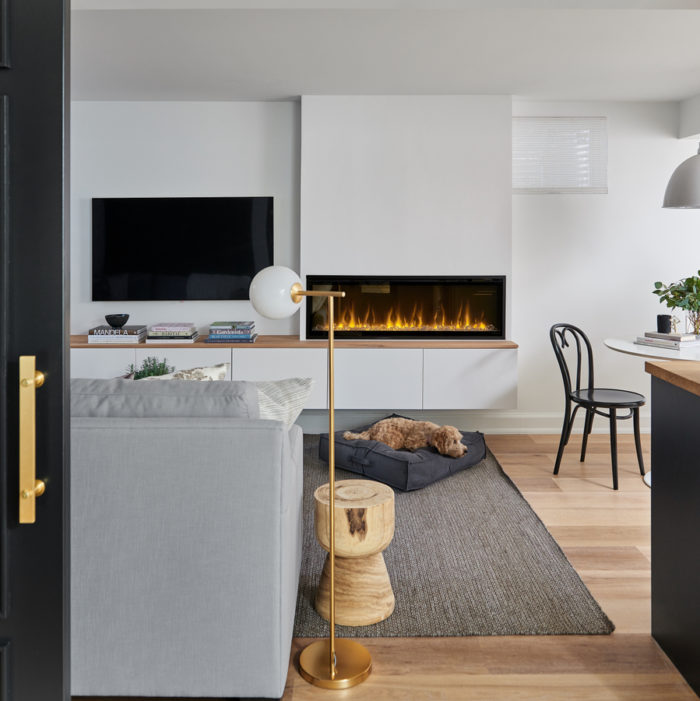Thank you for your positive comments and feedback on my One Room Challenge basement renovation. We love having this additional space to relax, exercise and practice yoga in. But what we also love is that the space is well lit, warm (thanks to our electric fireplace), practical and safe.
What you see is the beauty of the finishes and furniture but what transpired behind the walls, namely the electrical considerations is also important. The mandate of the Electrical Safety Authority (ESA) is to enhance electrical safety in Ontario. They teamed up with designer Kimberley Seldon to create Power Your Reno which showcases how important it is to consider electrical implications early in the design process and hire only a Licensed Electrical Contractor. Did you know that if you hire an unlicensed electrician (say, Uncle Albert) and something goes wrong (say, a fire), you are responsible? And, if an insurance claim can be traced back to work that was performed by an unlicensed electrician, the claim may be denied. How terrible would that be?
Lucky for me I don’t have a handy Uncle Albert and have always hired a Licensed Electrical Contractor for any work in my home, even hanging a light fixture. I also recommend this to even my handiest of clients, that they leave certain tasks like electrical to the professionals. I was surprised when doing a quick Google search how many self-professed “amateurs” are providing How To’s on electrical. Scary stuff.
My contractor brought in a Licensed Electrical Contractor around Day 5 of the basement renovation which is fairly early on. My first question to him was “is he/she licensed?” I certainly didn’t want to cut any corners and jeopardize the safety of my family. I’ve also learned that you can verify all Licensed Electrical Contractors on ESA’s website to be sure.
I had to be prepared with a Lighting/Electrical Plan to show where lighting and power should be placed. Like most basements, ours has just two small windows with window coverings which let in minimal light. So, lighting was a huge priority in the basement. I am not generally a fan of recessed lighting (pot lights) but I think basements are the one space where they are a necessity. But make sure the pot lights are on dimmers as they can be very bright, harsh and unwelcoming.
Electrical considerations need to be determined right at the onset of a project. Once the floor plan is completed, you can begin to prepare an electrical plan which can be as simple as drawing in the lighting and the electrical outlets on the floor plan. The following needs to be determined:
1) Location and quantity of pot lights. I actually had the Licensed Electrical Contractor rough in only four pot lights in the living room area of the basement but once they were in, I realized that two more were probably warranted. Best to err on the side of too much lighting rather than too little because it is costly and disruptive to fix after the fact when the ceiling and walls are up. Plus remember, dimmers are your friend.
2) Location and quantity of ceiling fixtures, pendants and wall sconces. You want to have a combination of varied light sources along with recessed lighting to create layered lighting and a comfortable environment. A furniture plan and any cabinetry layouts have to be done prior to the Licensed Electrical Contractor coming in so you know exactly where to tell them to hang the pendant over the dining table, for example.
3) The Licensed Electrical Contractor will place electrical outlets every few feet around the perimeter of the space. If you know that you will be needing one in a specific location, this is the time to let him/her know. In my case, I needed one high on the wall for the TV, one for the electric fireplace, one for the refrigerator (yet to be installed), one above the cabinetry for a coffeemaker or other small appliance or to charge phones, and one for the interactive system for my bike. Those all had to be in specific locations and a Licensed Electrical Contractor will know if they have different electrical considerations. Again, you want to get this right from the onset as it saves time and money.
4) If you were installing the latest television and sound system, your Licensed Electrical Contractor would advise if you need extra circuits or need to increase power requirements. He/she would also know the requirements for how far away electrical cables need to be from duct work and heating pipes to be safe.
 All photos by Stephani Buchman. Please note that the recessed lights were taken out of the photos.
All photos by Stephani Buchman. Please note that the recessed lights were taken out of the photos.
The bottom line is if you are hiring someone to do electrical work in Ontario, by law they must be a Licensed Electrical Contractor. To find or verify one in your area, visit findacontractor.esasafe.com. Visit poweryourreno.ca to learn more about how good design goes hand in hand with electrical safety. Of particular note is the Resources page which will come in handy for your next renovation or home project.
Happy renovations,
{Disclosure: This post was sponsored by the Electrical Safety Authority but all opinions are my own.}














Sandy
February 13, 2018I love your basement reno. We also have darker floors upstairs and I want lighter floors in my basement. I hope I can pull it off and make it look as seamless as you did.